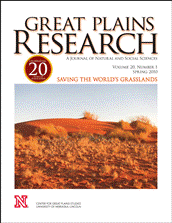Center for Great Plains Studies

Great Plains Research: A Journal of Natural and Social Sciences (through 2013)
Date of this Version
Spring 2004
Document Type
Article
Abstract
For any of us over the age of fifty, the weather has noticeably changed in our lifetime. Meteorologists, hydrologists, and climatologists have concentrated their efforts on assessing climate variations to a much greater degree than during the first half of the twentieth century. Thus the weather we perceive as changing apparently is changing, or at least we are becoming more aware of the forcing mechanisms associated with change. This book introduces the layperson to the basic fundamentals associated with the occurrence of two forms of natural disasters, floods and droughts, and to the potential influence of a changing climate on the frequency of these events. The commonality between these complex weather-related disasters, climate, is developed as the fundamental link to our understanding of their impact on humankind. To comprehend these extremes of weather, the authors contend, we must study them within the context of climate on a global scale, even if a weather event itself is regionally localized to no greater extent than a small drainage basin. By establishing the premise that floods and drought are not "aberrations," and do not occur either randomly or in cycles, the authors seek to explain the complexities of a weather machine that produces patterns of precipitation, wind, and temperature as manifestations of meteorological extremes.


Comments
Published in Great Plains Research Vol. 14, No. 1, 2004. Copyright © 2004 The Center for Great Plains Studies, University of Nebraska–Lincoln. Used by permission.